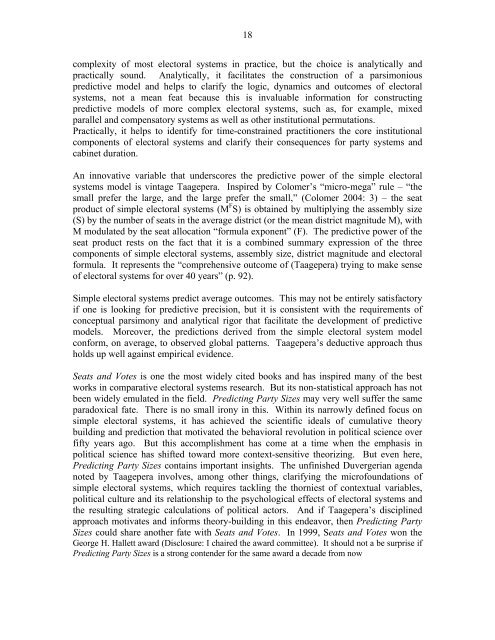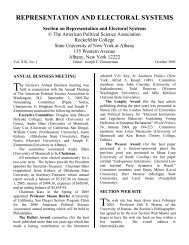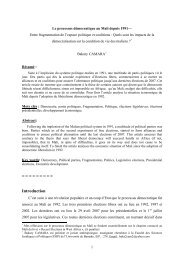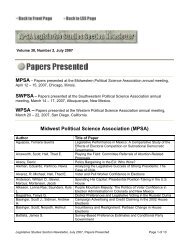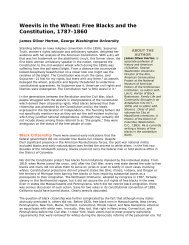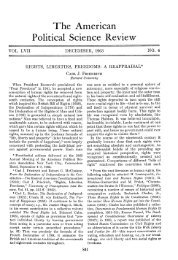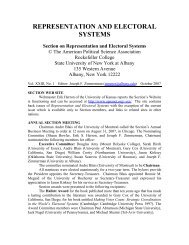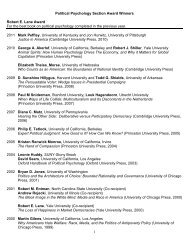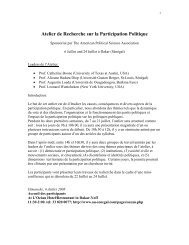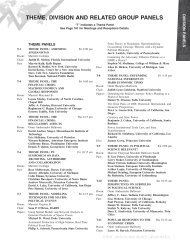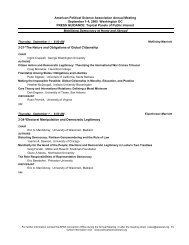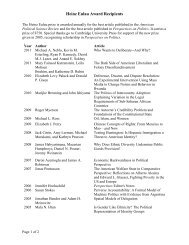representation and electoral systems - American Political Science ...
representation and electoral systems - American Political Science ...
representation and electoral systems - American Political Science ...
You also want an ePaper? Increase the reach of your titles
YUMPU automatically turns print PDFs into web optimized ePapers that Google loves.
18<br />
complexity of most <strong>electoral</strong> <strong>systems</strong> in practice, but the choice is analytically <strong>and</strong><br />
practically sound. Analytically, it facilitates the construction of a parsimonious<br />
predictive model <strong>and</strong> helps to clarify the logic, dynamics <strong>and</strong> outcomes of <strong>electoral</strong><br />
<strong>systems</strong>, not a mean feat because this is invaluable information for constructing<br />
predictive models of more complex <strong>electoral</strong> <strong>systems</strong>, such as, for example, mixed<br />
parallel <strong>and</strong> compensatory <strong>systems</strong> as well as other institutional permutations.<br />
Practically, it helps to identify for time-constrained practitioners the core institutional<br />
components of <strong>electoral</strong> <strong>systems</strong> <strong>and</strong> clarify their consequences for party <strong>systems</strong> <strong>and</strong><br />
cabinet duration.<br />
An innovative variable that underscores the predictive power of the simple <strong>electoral</strong><br />
<strong>systems</strong> model is vintage Taagepera. Inspired by Colomer’s “micro-mega” rule – “the<br />
small prefer the large, <strong>and</strong> the large prefer the small,” (Colomer 2004: 3) – the seat<br />
product of simple <strong>electoral</strong> <strong>systems</strong> (M F S) is obtained by multiplying the assembly size<br />
(S) by the number of seats in the average district (or the mean district magnitude M), with<br />
M modulated by the seat allocation “formula exponent” (F). The predictive power of the<br />
seat product rests on the fact that it is a combined summary expression of the three<br />
components of simple <strong>electoral</strong> <strong>systems</strong>, assembly size, district magnitude <strong>and</strong> <strong>electoral</strong><br />
formula. It represents the “comprehensive outcome of (Taagepera) trying to make sense<br />
of <strong>electoral</strong> <strong>systems</strong> for over 40 years” (p. 92).<br />
Simple <strong>electoral</strong> <strong>systems</strong> predict average outcomes. This may not be entirely satisfactory<br />
if one is looking for predictive precision, but it is consistent with the requirements of<br />
conceptual parsimony <strong>and</strong> analytical rigor that facilitate the development of predictive<br />
models. Moreover, the predictions derived from the simple <strong>electoral</strong> system model<br />
conform, on average, to observed global patterns. Taagepera’s deductive approach thus<br />
holds up well against empirical evidence.<br />
Seats <strong>and</strong> Votes is one the most widely cited books <strong>and</strong> has inspired many of the best<br />
works in comparative <strong>electoral</strong> <strong>systems</strong> research. But its non-statistical approach has not<br />
been widely emulated in the field. Predicting Party Sizes may very well suffer the same<br />
paradoxical fate. There is no small irony in this. Within its narrowly defined focus on<br />
simple <strong>electoral</strong> <strong>systems</strong>, it has achieved the scientific ideals of cumulative theory<br />
building <strong>and</strong> prediction that motivated the behavioral revolution in political science over<br />
fifty years ago. But this accomplishment has come at a time when the emphasis in<br />
political science has shifted toward more context-sensitive theorizing. But even here,<br />
Predicting Party Sizes contains important insights. The unfinished Duvergerian agenda<br />
noted by Taagepera involves, among other things, clarifying the microfoundations of<br />
simple <strong>electoral</strong> <strong>systems</strong>, which requires tackling the thorniest of contextual variables,<br />
political culture <strong>and</strong> its relationship to the psychological effects of <strong>electoral</strong> <strong>systems</strong> <strong>and</strong><br />
the resulting strategic calculations of political actors. And if Taagepera’s disciplined<br />
approach motivates <strong>and</strong> informs theory-building in this endeavor, then Predicting Party<br />
Sizes could share another fate with Seats <strong>and</strong> Votes. In 1999, Seats <strong>and</strong> Votes won the<br />
George H. Hallett award (Disclosure: I chaired the award committee). It should not a be surprise if<br />
Predicting Party Sizes is a strong contender for the same award a decade from now


